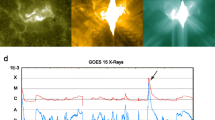Abstract
We have studied chromospheric mass injection into an overlying coronal dipole magnetic field using a 2-D ideal magnetohydrodynamic (MHD) numerical model. The results indicate that such injection can produce magnetic field deformation conducive to active region prominences - namely, Kippenhahn-Schlüter (K-S) type configurations for stable support of injected plasma. We show the optimum conditions for such dynamical formation of K-S-type field configurations.
Observations show that an active region prominence formation is preceded by the accumulation of absorptive strands above a neutral line. We hypothesize that an absorptive strand is formed by a chromospheric asymmetric mass injection into the overlying coronal magnetic field and that a necessary condition for the accumulation of the strands is that the mass injection forms a K-S-type field configuration. The results of our numerical simulation of the injection dynamics support our hypothesis. To form a K-S-type magnetic field configuration, we find that a narrow range of injection density, velocity, and magnetic field strength must be used; spicule-like, asymmetric mass injection seems favorable.
The limited parameter range that exists for the formation of K-S-type magnetic field configurations in asymmetric injections may explain why active region prominences do not form everywhere on every neutral line.
Similar content being viewed by others
References
An, C.-H., Canfield, R. C., Fisher, G. H., and McClymont, A. N.: 1983, Astrophys. J. 267, 421.
An, C.-H., Bao, J. J., and Wu, S. T.: 1986, in Proceedings of the Coronal and Prominence Plasmas Workshop, NASA Publication 2442, p. 51.
Hu, Y. Q. and Wu, S. T.: 1984, J. Compt. Phys. 55, 33.
Kippenhahn, R. and Schlüter, A.: 1957, Z. Astrophys. 43, 36.
Leroy, J. L.: 1978, Astron. Astrophys. 64, 247.
Livi, S. H. B., Wang, J., and Martin, S. F.: 1985, Australian J. Phys. 38, 855.
Martin, S.: 1973, Solar Phys. 31, 3.
Martin, S.: 1986, in Proceedings of the Coronal and Prominence Plasma Workshop, NASA Publication 2442, p. 73.
Martin, S., Livi, S. H. B., and Wang, J.: 1985, Australian J. Phys. 38, 929.
Pikel'ner, S. B.: 1969, Soviet Astron.-AJ 13, 259.
Rompolt, B. and Bogdan, T.: 1986, in Proceedings of the Coronal and Prominence Plasma Workshop, NASA Publication 2442, p. 81.
Simon, G., Schmieder, B., Demoulin, P., Malherbe, J. M., and Poland, A. I.: 1986, in Proceedings of the Coronal and Prominence Plasma Workshop, NASA Publication 2442, p. 177.
Smith, E. V. P.: 1968, Nobel Symp. 9, 137.
Tandberg-Hansen, E.: 1974, Solar Prominences, D. Reidel Publ. Co., Dordrecht, Holland.
Wu, S. T., Hu, Y. Q., Nakagawa, Y., and Tandberg-Hanssen, E.: 1983, Astrophys. J. 266, 866.
Wu, S. T., Hu, Y. Q., Nakagawa, Y., and Tandberg-Hanssen, E.: 1986, Astrophys. J. 306, 751.
Author information
Authors and Affiliations
Rights and permissions
About this article
Cite this article
An, CH., Bao, J.J. & Wu, S.T. Numerical simulation of mass injection for the formation of prominence magnetic field configurations. Sol Phys 115, 81–92 (1988). https://doi.org/10.1007/BF00146231
Received:
Revised:
Issue Date:
DOI: https://doi.org/10.1007/BF00146231




